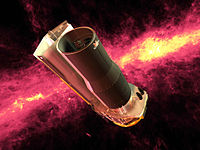
Photo from wikipedia
When did galaxies start forming stars? What is the role of distant galaxies in galaxy formation models and the epoch of reionization? What are the conditions in typical star-forming galaxies… Click to show full abstract
When did galaxies start forming stars? What is the role of distant galaxies in galaxy formation models and the epoch of reionization? What are the conditions in typical star-forming galaxies at redshifts ≳4? Why is galaxy evolution dependent on environment? The Spitzer Space Telescope has been a crucial tool for addressing these questions. Accurate knowledge of stellar masses, ages and star formation rates requires measuring rest-frame optical (and ultraviolet) light, which only Spitzer can probe at high redshifts for a sufficiently large sample of typical galaxies. Many of these science goals are the main science drivers for the James Webb Space Telescope, and Spitzer afforded us their first exploration. The Spitzer Space Telescope accurately measured stellar masses, ages and star formation rates for a large sample of typical galaxies at high redshifts, allowing an initial exploration of some of the key science drivers of the James Webb Space Telescope.
Journal Title: Nature Astronomy
Year Published: 2020
Link to full text (if available)
Share on Social Media: Sign Up to like & get
recommendations!